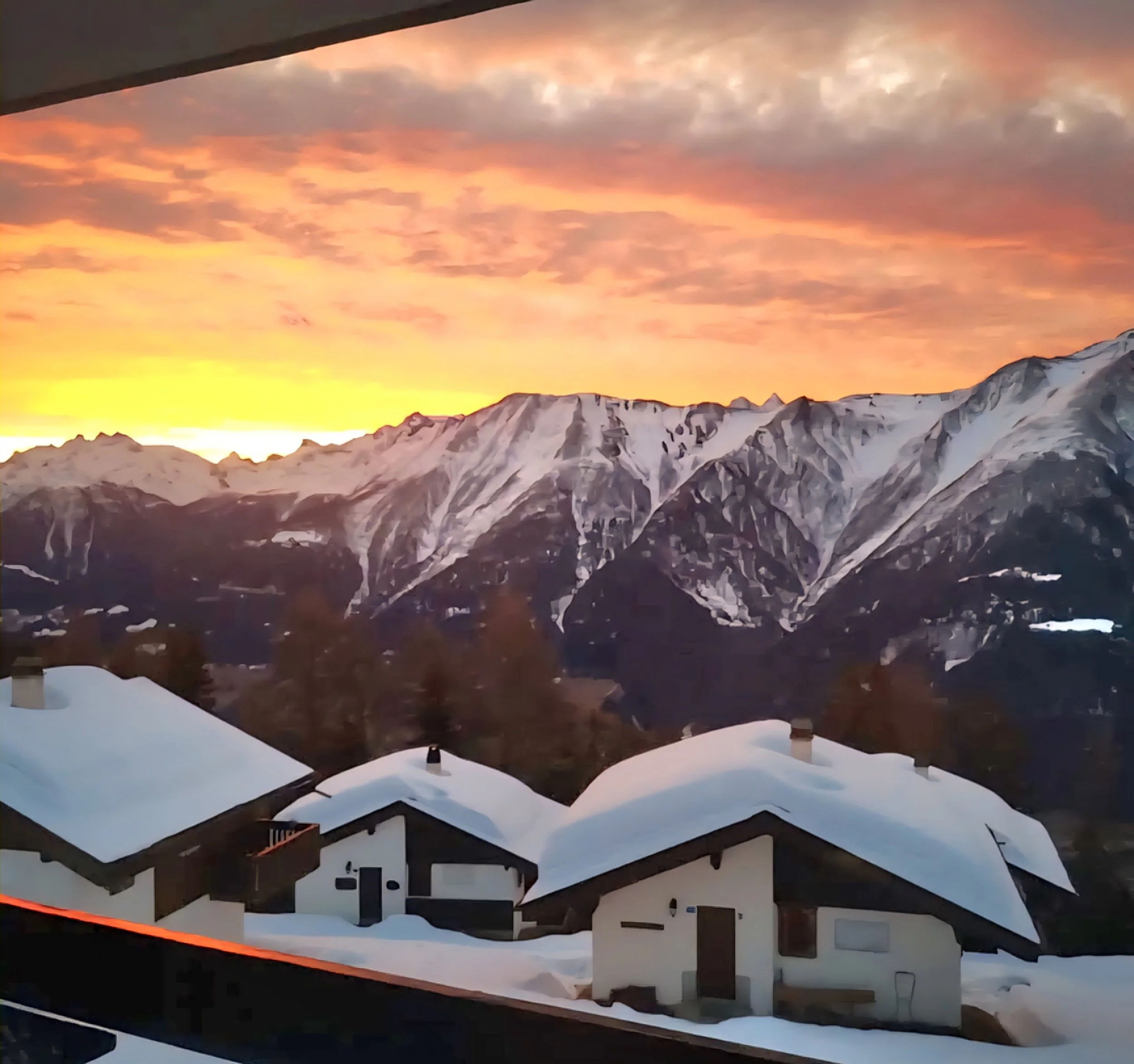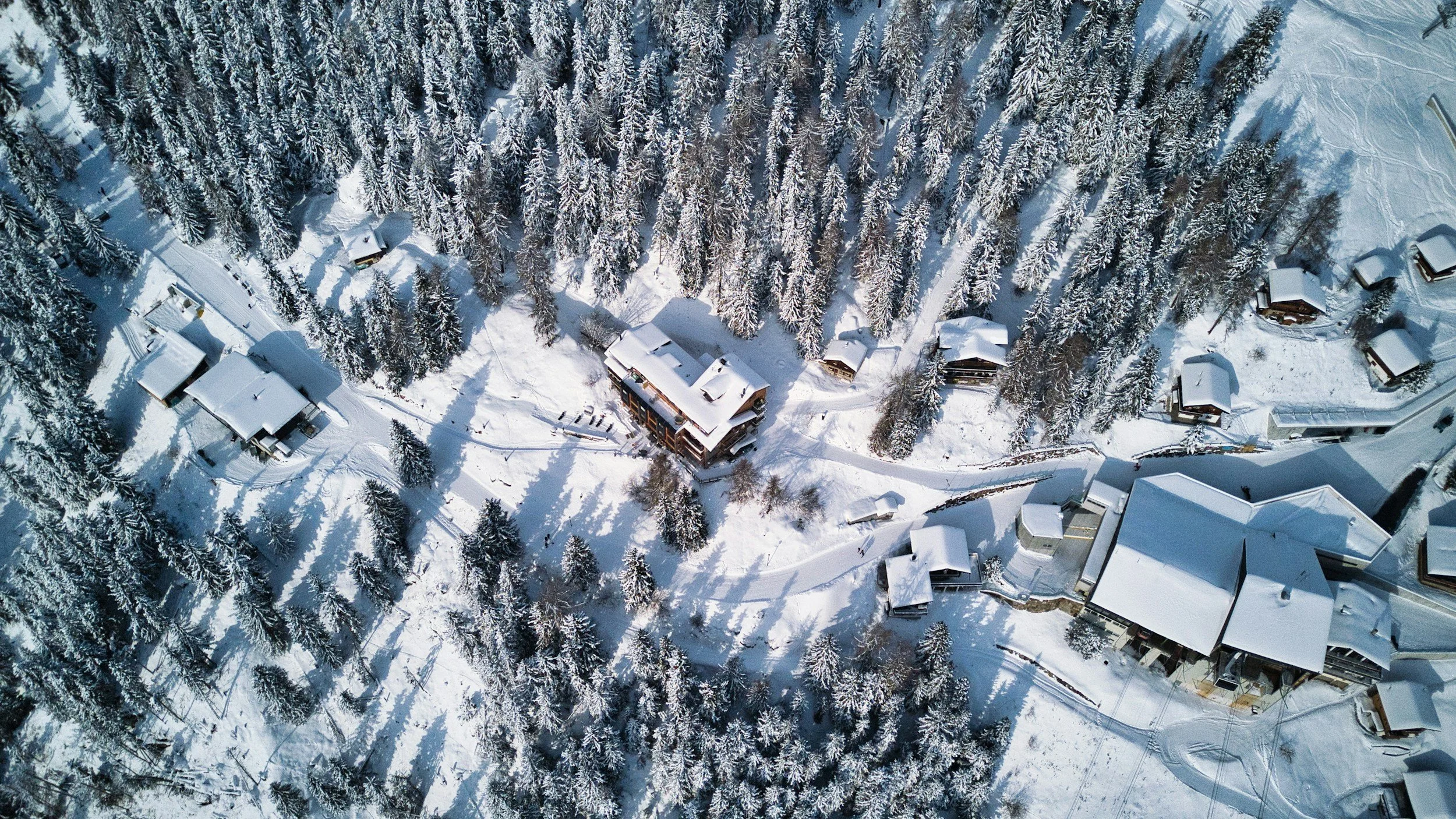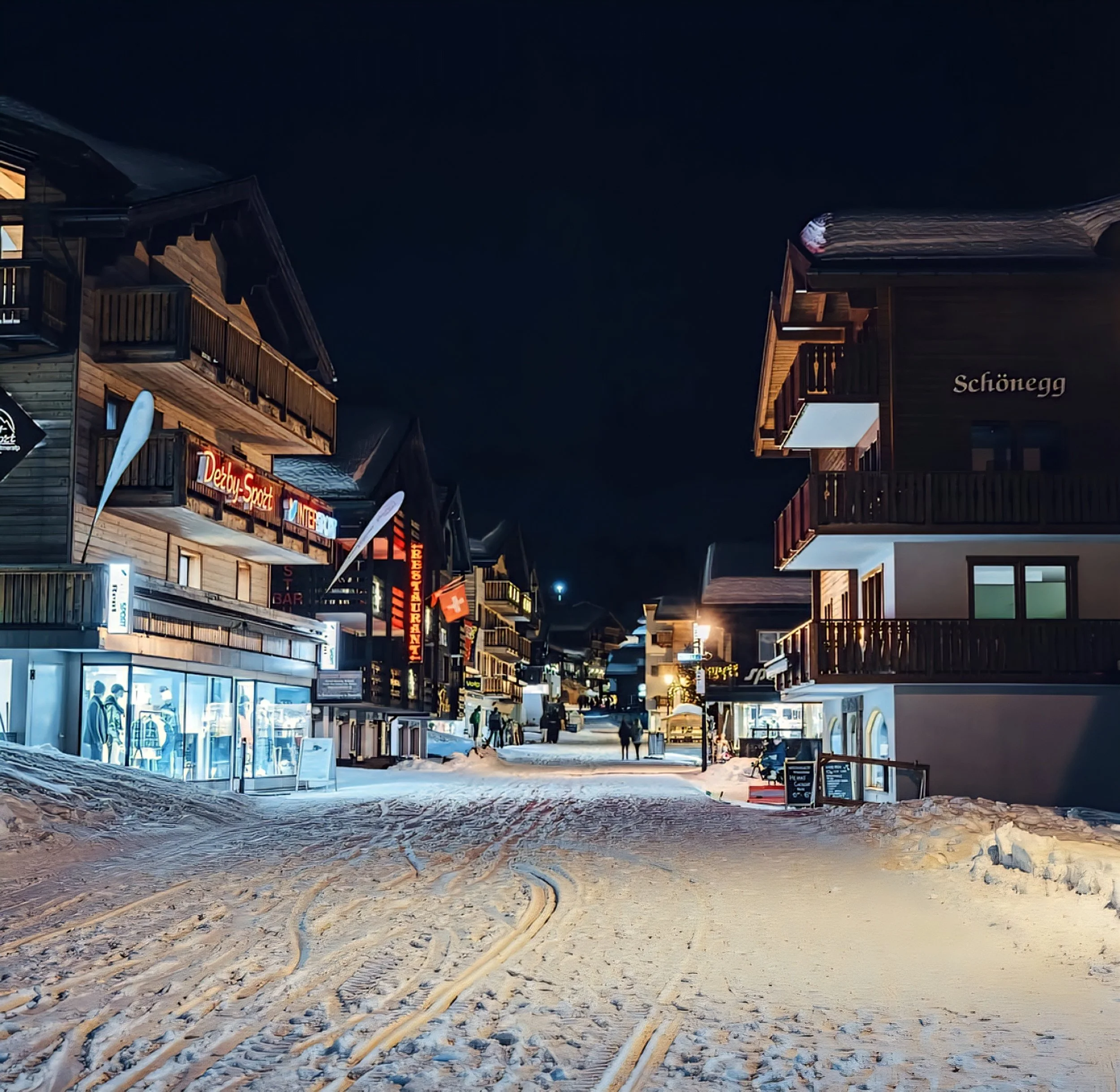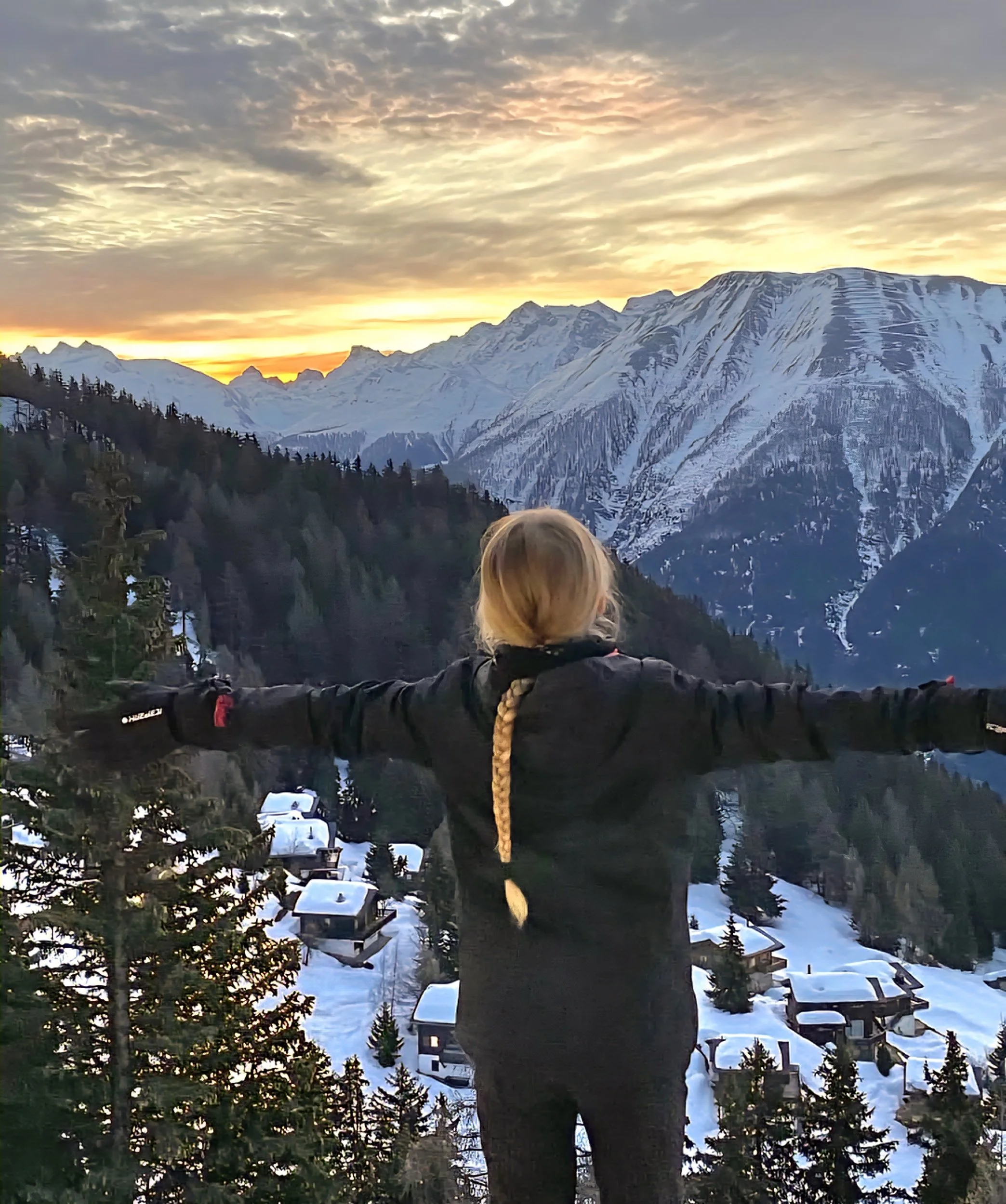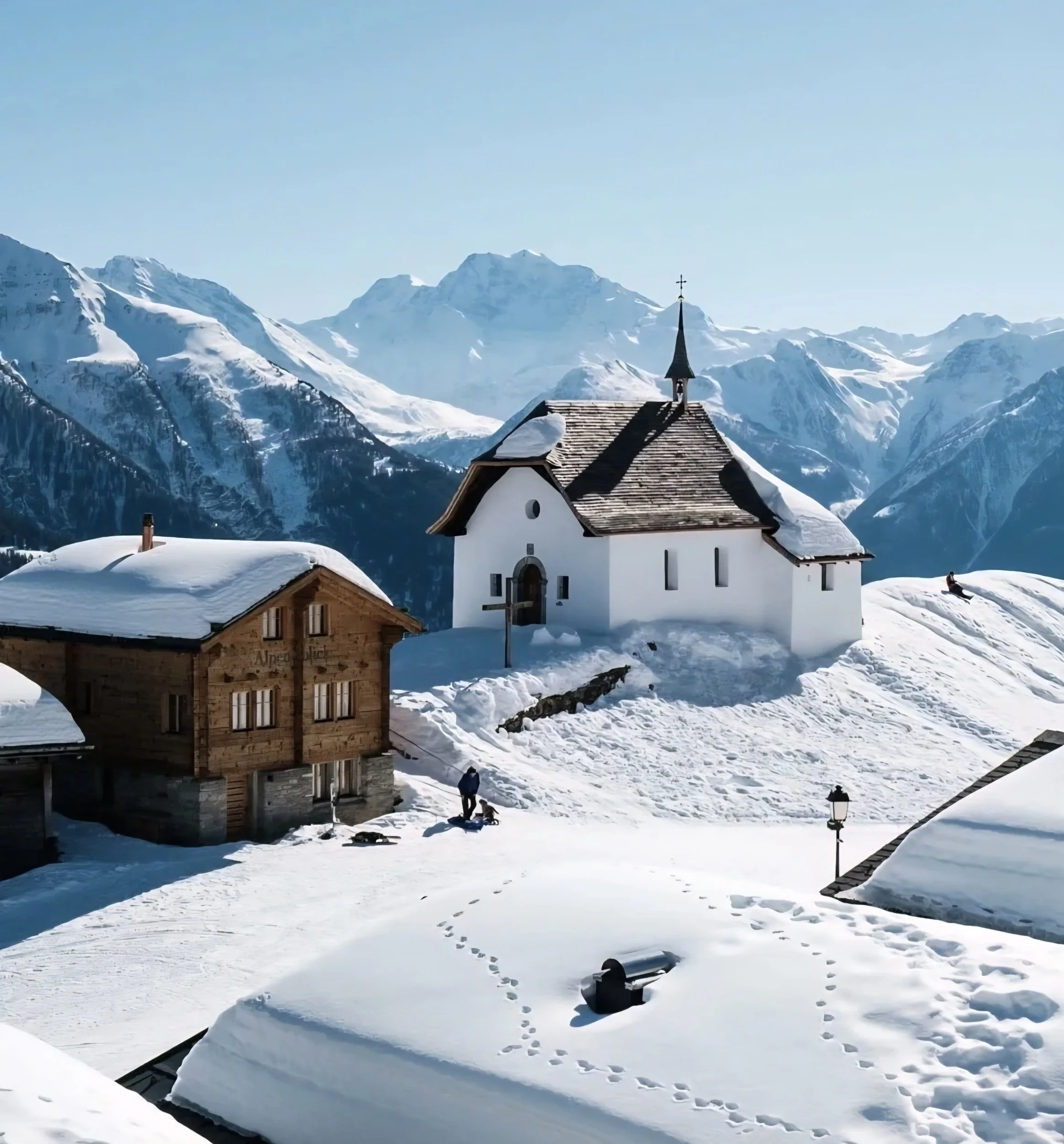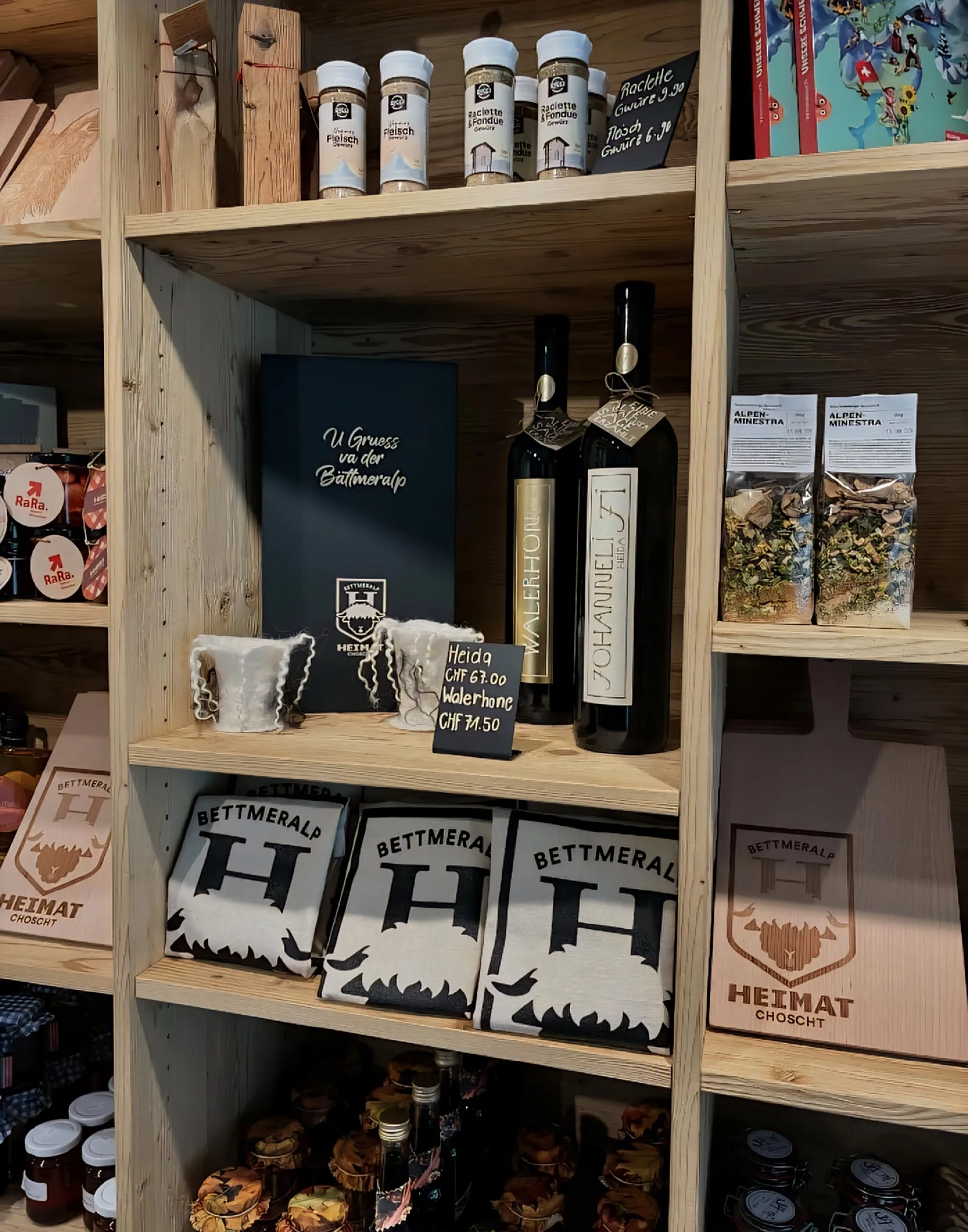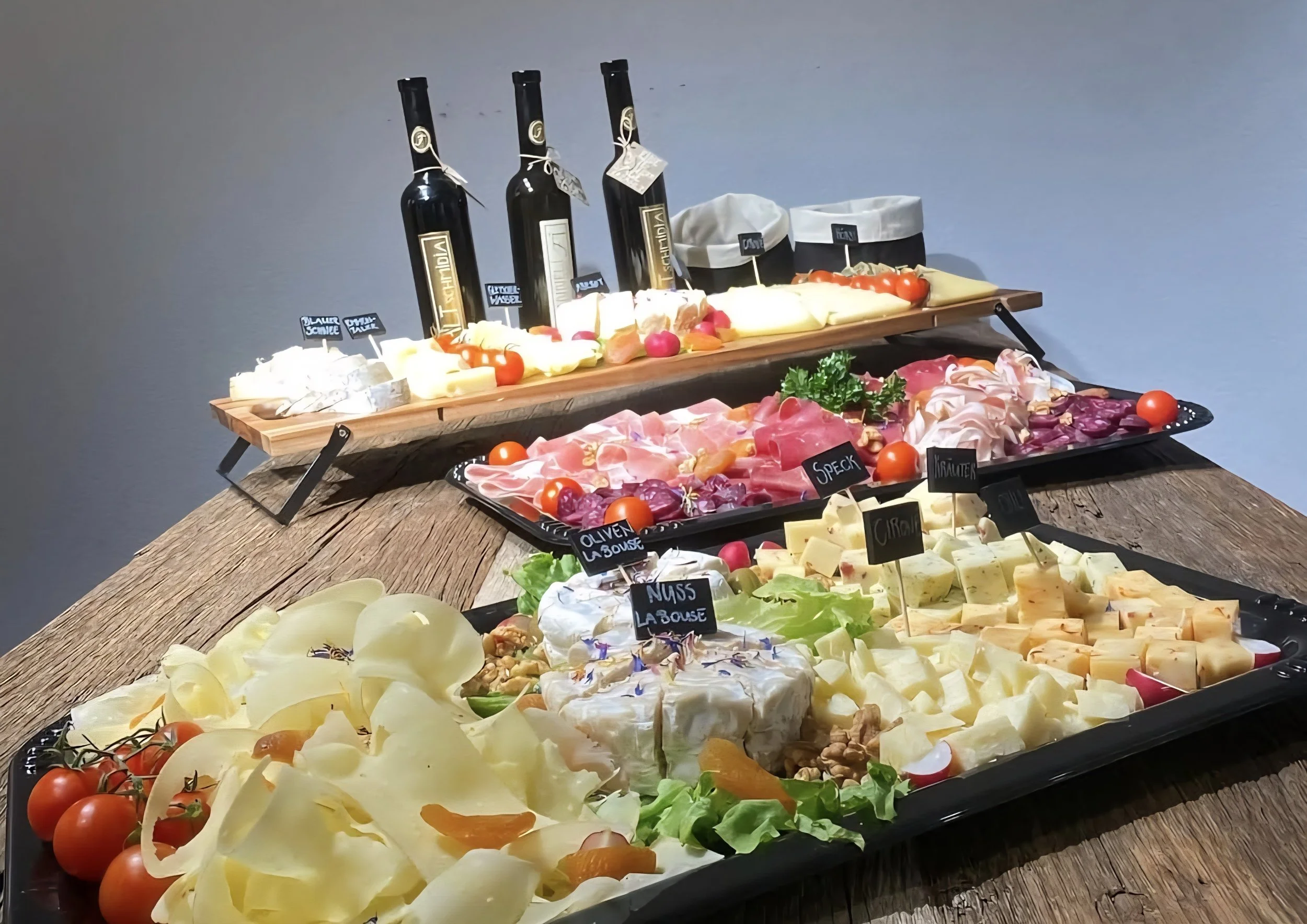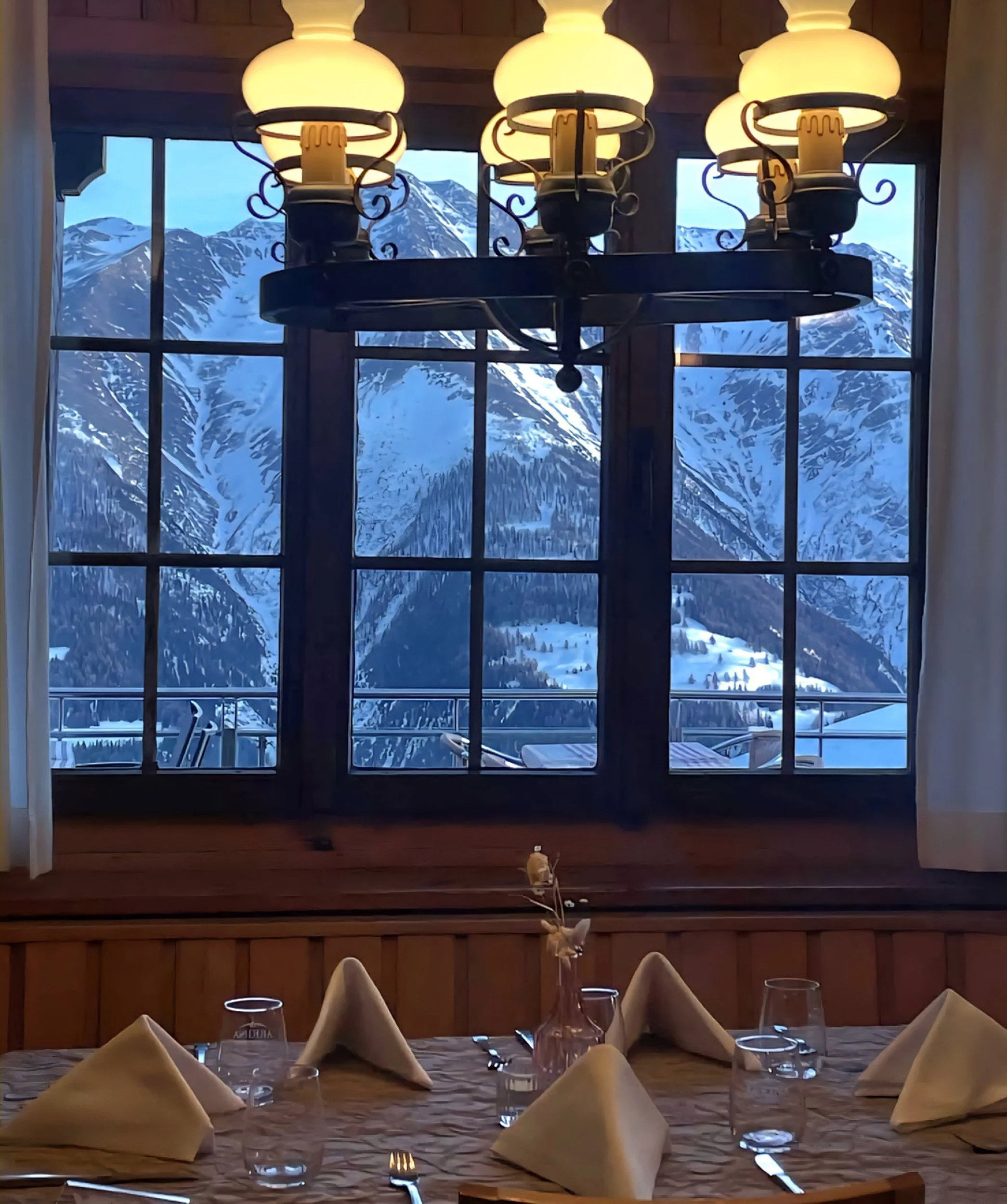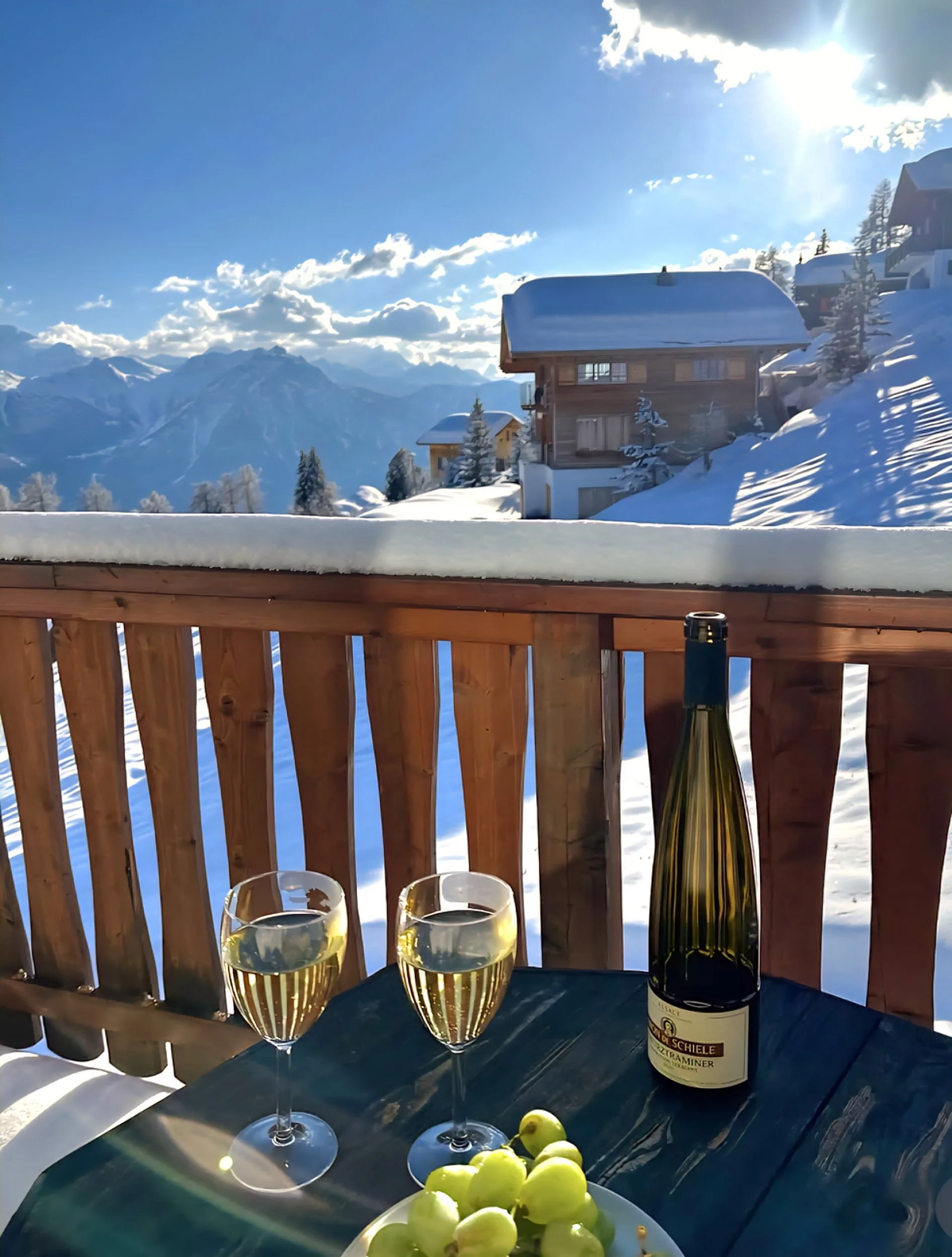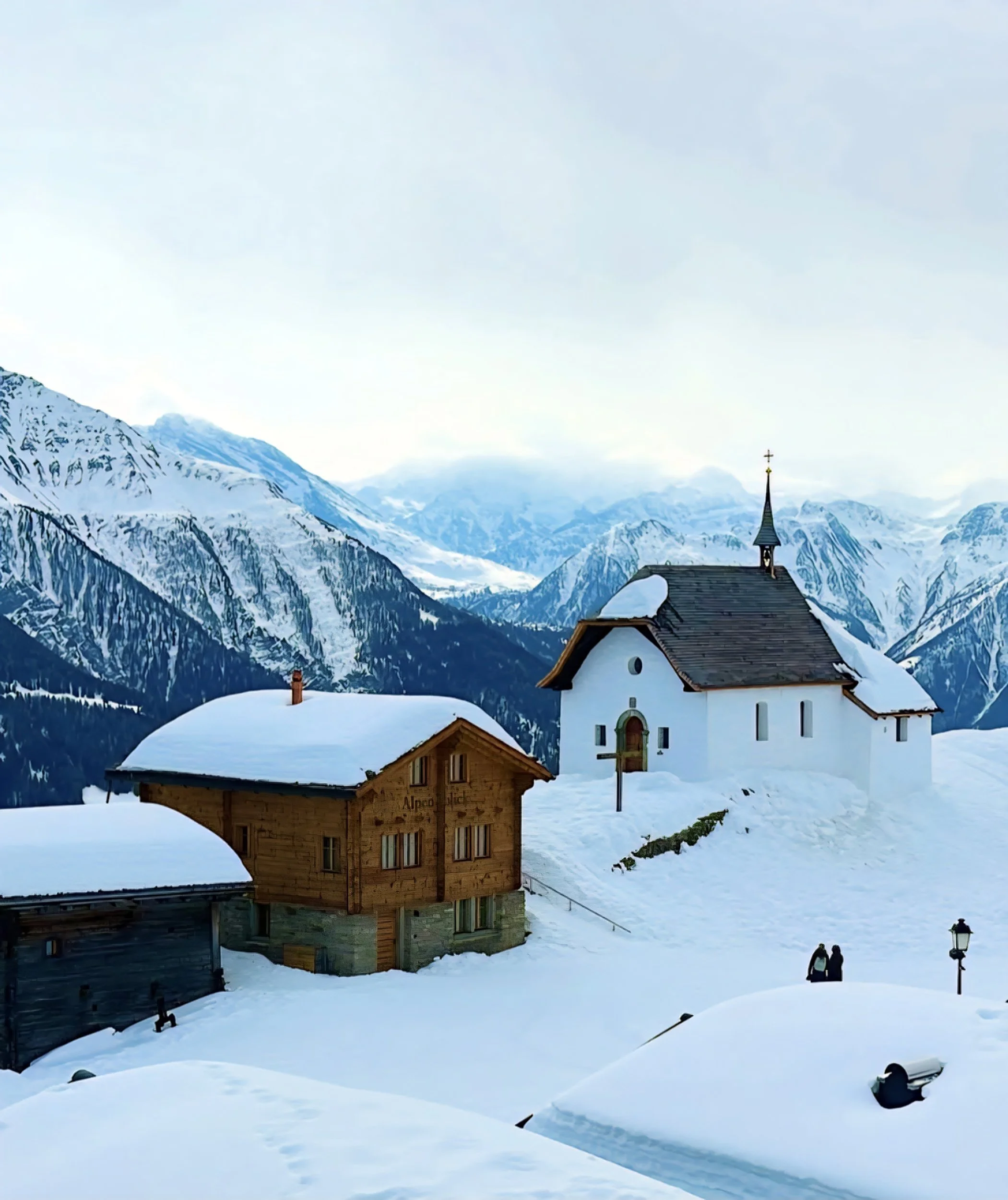Bettmeralp: The car-free Swiss Winter Village with Glacier Views
Bettmeralp is the kind of place that’s easy to miss on a map but hard to forget once you’ve been. It sits high above the Rhône Valley in southern Switzerland, in a part of the Alps that still feels lived-in and calm. You get up there by cable car, and when you step out, the first thing you notice is the quiet. No cars. No traffic. Just snow underfoot and wide views in every direction. STUNNING.
The village itself is small. It’s mostly wooden chalets, a few cafés, a bakery, and some family-run guesthouses. You walk everywhere. Kids drag sleds along the paths, people greet each other by name, and the pace of life feels steady, not seasonal. It’s not a resort built for tourists; it’s a place where you need to embrace the slow living lifestyle, otherwise you won’t enjoy it here.
The view is what usually draws people here. From almost anywhere in the village, you can see the Aletsch Glacier, a 20-kilometer stretch of slow-moving ice that feels almost otherworldly when the sky is clear. On some mornings, it catches the early light so perfectly that you’ll stand there a little longer than planned…
Bettmeralp is part of the Aletsch Arena, along with Riederalp and Fiescheralp - three car-free villages connected by trails and lifts. You can walk or ski between them, stop for lunch at a mountain hut, or just sit outside and watch clouds drift over the peaks. There’s plenty to do, but nobody here seems in a rush to do it.
If you come in winter, it’s not just about skiing - though you can, and the slopes are quiet compared to bigger resorts. It’s more about slow days: walking snowy paths between chalets, sitting on a terrace with a bowl of soup, or reading by the window while snow falls outside. It’s the kind of trip where the simple moments like the smell of woodsmoke, the crunch of snow, the silence at night, end up being the things you remember.
Getting here is easy, even without a car. You take the train to Betten Talstation, then a short cable car ride up to the village. Everything after that happens on foot.
If what you want from winter is calm, clear air, and time that moves a bit slower, Bettmeralp is the place that gives you that.
How to Get to Bettmeralp in Winter (by Public Transport)
One of the things that makes Bettmeralp special is also what makes it a little less obvious to get to: it’s a car-free village, which means you’ll need to switch to a cable car for the last stretch. But that doesn’t mean it’s difficult! In fact, arriving without a car is part of the experience.
Here’s exactly how to get there.
Step 1: Take the train to Betten Talstation
Train view
The most direct route is to take the train to Betten Talstation, the valley station for Bettmeralp. You’ll likely connect through Brig or Visp, depending on where you’re coming from. Both towns are well connected to Swiss cities like Bern, Zurich, Lausanne, and Geneva via the SBB (Swiss Federal Railways).
From Brig or Visp, it’s a short regional train ride to Betten Talstation - usually under 30 minutes. Trains run all year and are reliable, even in winter.
If you’re flying into Switzerland, you can go directly from Zurich Airport to Brig without changing trains.
Step 2: Ride the cable car up to Bettmeralp
Once you reach Betten Talstation, it’s just a short walk (literally a minute or two) from the platform to the cable car station. These run frequently throughout the day, even in winter, and take you straight up to Bettmeralp in about 7 minutes.
The views during the ride are a preview of what’s to come: snow-covered roofs, forested slopes, and finally, the rooftops of the village appearing as you glide in.
Cable car tickets can be bought on-site or in advance, and your luggage comes with you in the cabin.
Luggage
If you’re staying at a guesthouse or hotel, check if they offer luggage transport from the top station. Many do - and they’ll meet you when you arrive with a small snow vehicle or sledge, especially if you’re carrying gear or groceries.
How to Spend a Winter Day in Bettmeralp
You don’t need skis to enjoy Bettmeralp in winter. In fact, if you’re the kind of traveler who prefers quiet paths and slow mornings, not skiing might be the better choice.
Start with a walk through the village. Mornings are calm - just the sound of boots on snow, a few sleds being pulled past chalets, and the bakery opening up. Grab something fresh, maybe a buttery croissant or a slice of nut loaf, and take your coffee outside. There’s always a bench nearby with a view.
The winter walking trails here are one of the best parts of staying in the Aletsch Arena. They’re well-marked and easy to follow, just weat decent shoes and you’ll be fine. You can head out toward Riederalp or down to the glacier lookout points. But you don’t have to go far. Even a short walk gives you that quiet, clear-mind feeling that winter does so well.
In the afternoon, the pace doesn’t pick up much - and that’s the beauty of this place. Settle into a café where locals stop for a hot drink after errands. Read, write postcards, or do nothing. A lot of guesthouses have games, books, or just good windows to sit by.
Later on, if you feel like moving again, try one of the sled runs - some stay open after dark and are more about fun than speed. Or just go for another walk before dinner. The village paths are lit just enough to guide you but still feel peaceful, and you’ll probably pass more snowcats than people.
There’s no pressure here to plan your day around activities. If all you do is take a few walks, have something warm to eat, and look at the mountains: that’s a good day.
Things to Do in Bettmeralp in Winter (Even If You’re Not Here to Ski)
Bettmeralp doesn’t require a long list of things to do. That’s why you come here to relax. It’s the kind of place where the best parts of your day might be a simple walk, a good view, or an hour in a quiet café. Still, if you’re planning a few days here, these are some of the most enjoyable and easygoing winter activities - especially if you’re not the type to spend all day on skis.
Walk the groomed winter trails between Bettmeralp, Riederalp, and Fiescheralp
One of the easiest and most satisfying ways to explore this region is on foot. There are well-prepared winter hiking paths that connect Bettmeralp with the neighboring car-free villages of Riederalp and Fiescheralp. These are wide, snow-packed trails (not backcountry hikes) so you don’t need anything fancy to walk them. Warm boots, gloves, and a bit of time is enough.
Along the way, you’ll pass wooden barns, mountain huts, and panoramic viewpoints over the Aletsch Glacier and the Matterhorn. There’s often barely anyone around. You can stop for lunch in one village and walk back in the afternoon, or just do part of the trail and turn around whenever you feel like it.
Take the cable car to Bettmerhorn for a close view of the Aletsch Glacier
From Bettmeralp, you can take a quick cable car ride up to Bettmerhorn: one of the best places to get a full, wide-angle view of the Aletsch Glacier. It’s a huge stretch of ice that runs for more than 20 kilometers, and seeing it from above gives you a real sense of how massive and quiet this part of the Alps is.
At the top, there’s a viewing platform and a small café if you want to stay a while. Even in cold weather, it’s worth stepping outside - especially on a clear day! You don’t need a guide or a tour to do this; just walk to the lift station, ride up, and take your time at the top.
Do as little as possible (and enjoy it)
It sounds like non-advice, but the best thing about staying in a quiet alpine village like Bettmeralp is the chance to do almost nothing. You don’t need an itinerary. Bring a book. Pick up some cheese and bread from the local shop. Go for a walk in the morning, then come back and take a nap or sit by the window with tea.
You don’t come here to be entertained. You come to take a break from everything that usually needs your attention. There’s enough calm here to help you actually unwind.
Try snowshoeing or sledging (no experience needed)
If you want a little movement without going skiing, snowshoeing is a good option. There are several marked snowshoe trails that loop out from the village, some through pine forest, others over open ground with views of the peaks. You can rent snowshoes at most sports shops in the village, and the trails are clearly signposted.
Sledging is also popular here, and it’s not just for families. There’s a long sledge run that goes down from Bettmeralp toward Betten Dorf, and you can ride the lift back up. It’s a low-effort, fun way to spend part of the afternoon. You’ll find sleds for rent in the village too.
Have lunch at a mountain hut and walk back
There are several mountain restaurants within walking or ski distance, and they’re open in winter. These places don’t feel like part of a ski circus… they’re smaller, quieter, and usually run by local families. Try simple dishes like barley soup, rösti, or a plate of cheese and dried meat from the region.
One nice option is to walk to Riederalp, have lunch, and then return in the afternoon. The paths are easy to follow, and the walk gives you a reason to spend more time outdoors.
Where to Stay in Bettmeralp in Winter (Cozy Chalets, Small Hotels & Snowy Views)
Because Bettmeralp is car-free, everything feels more compact - and more peaceful. You won’t find big ski resorts or high-rise hotels here. Most of the places to stay are independent chalets, small inns, or apartments run by locals who actually live in the village. That’s part of what makes it feel different.
Here are a few solid options if you’re planning a winter stay.
Chalet-Hotel Bettmerhof
If you want comfort without losing that “small mountain village” feel, Bettmerhof is a good pick. It’s a family-run hotel with simple but warm rooms, many with views over the valley or glacier. Breakfast is local with fresh bread, alpine cheese, boiled eggs - and the location is quiet, just above the main part of the village.
The owners are hands-on, and they’ll give you real advice about where to walk or eat that day. They also offer luggage transport from the lift station, which makes arrival easy if you’re coming by train.
Ferienhaus Waldhaus — Private Chalet Rentals
For travelers who want their own space, Waldhaus offers cozy self-catering chalets and apartments with fully equipped kitchens and fireplaces. Some have large balconies facing the glacier, which is ideal if you just want to stay in, cook, and watch the sky change. It’s especially nice for couples or families planning to stay a bit longer.
Staying here means you can do things at your own pace: make breakfast slowly, come back in the afternoon and light the stove, or just stay in with tea and a board game. It’s also well-located for winter hiking trails.
Hotel Slalom
Right in the village center, Hotel Slalom offers a casual but stylish base with glacier views and a laid-back atmosphere. Rooms are clean and modern, and there’s a bar on-site if you want a nightcap without heading far. It’s close to the lifts and walking trails, but also easy to retreat from the crowds - if you can call them that here.
It’s a good fit for solo travelers, couples, or anyone looking for car-free winter accommodation that doesn’t feel overly rustic or remote.
How to Choose
If you’re only staying 2–3 nights, book something central close to the lift station and village main street. That way you don’t spend your time hauling bags or walking in the cold after dark. For longer stays, consider chalets on the village edges with open views and more quiet. Many come with full kitchens, fireplaces, and balconies made for morning coffee in the snow.
What to Eat in Bettmeralp in Winter
Bettmeralp isn’t about fancy food or long tasting menus. It’s the kind of place where you end up eating things that make sense in cold weather: hot soup, melted cheese, potatoes, hearty meat plates. Meals are usually slow, filling, and unpretentious - often served by someone who’s lived here their whole life.
Here’s what to look for once you’ve settled in and started wondering where to eat.
Cheese fondue, the way locals eat it
You’ll find fondue on almost every menu in Bettmeralp, and for good reason. It’s a proper winter meal: warm, social, and exactly what you want after a long walk or an afternoon outside. In this region, it’s typically made with local mountain cheeses like raclette or Tomme, and served with bread, potatoes, and sometimes a little cured meat on the side.
The best way to enjoy it? Skip lunch, go hungry, and don’t rush.
Two relaxed places that serve it well: the Panorama-Restaurant at Bettmerhorn if you’re up the mountain, or Restaurant Alpina in the village.
Rösti that’s crisp and filling
This simple potato dish is everywhere in Switzerland, but in alpine villages like Bettmeralp, it just hits different. Rösti is grated potatoes fried into a golden crust - sometimes topped with an egg, bacon, or melted cheese. It’s not fancy, and that’s the point. One plate can easily fuel the rest of your afternoon.
Waldhaus Restaurant does a good, classic version, and the portions are generous without overdoing it.
Local cheese, dried meats, and bread
When you don’t feel like sitting down to a big meal, order an “assiette valaisanne” - basically a board of air-dried meats, slices of mountain cheese, pickles, and rustic bread. It’s a typical Valais snack plate, and you’ll find it in most huts and inns.
If you’re staying in a chalet and want to DIY a version for lunch or dinner, the village’s main shop (Volg) stocks a surprisingly decent selection of cheese, sausage, and fresh bread daily. You don’t need to go anywhere fancy to eat well here.
Something sweet in the afternoon
Whether you’re out walking or just warming up after a few hours in the snow, it’s worth making time for coffee and cake. Nusstorte (a caramelised nut tart) and strudel are common in winter, and you’ll find both at the local bakery or on many café menus.
The bakery in the center of the village (Imhof) is good for takeaway pastries or morning croissants. A few guesthouses also serve homemade cakes to guests in the afternoon, especially if you’re staying in a smaller place with just a few rooms.
Local Wine and Cheese You Need to Try
You don’t need to visit a vineyard to enjoy good wine in Bettmeralp - but it helps to know what to look for. This part of Switzerland sits in the canton of Valais, one of the country’s best wine regions. Most of it doesn’t get exported, so the wines you drink here are truly local,and honestly, that’s part of the fun.
Valais Wines to Know
The white wine you’ll see everywhere is Fendant: light, crisp, and the kind of thing you drink with cheese or sip in the late afternoon when the sun’s out but the air’s still cold. It’s made from the Chasselas grape and shows up on just about every menu. It’s not fancy, but it’s good.
If you’re after something a little more complex, look for Petite Arvine: a Valais specialty that’s a bit more floral and mineral, still very drinkable. For reds, try Humagne Rouge or Cornalin. They’re deeper, a little earthy, and go well with alpine food, like rösti, dried meats, anything with melted cheese.
Most little shops in the village carry local bottles, and staff are usually happy to recommend something. Don’t overthink it - it’s all meant to be enjoyed casually, not analyzed.
Cheese That Tastes Like the Alps
Swiss cheese goes way beyond fondue. In Valais, one of the best things you can pick up is Alpkäse: made in high alpine huts during the summer and aged through the fall and winter. It’s nutty, firm, and full of character.
Other good picks:
Raclette cheese: Even if you don’t have a raclette grill, this melts easily in a pan or oven. Pair it with boiled potatoes and pickles and you’ve got a classic Swiss dinner.
Tomme du Valais: Soft, mild, and good with bread or a slice of pear.
You’ll find these at the village shop, the bakery (yes, really), or at mountain huts if you stop in for a snack during a walk.
If you’re self-catering, stock up on a few types, open a bottle of local wine, and make your own alpine tasting night. This should a be non-negotiable on your visit here…
Where to Eat Like a Local in Bettmeralp
For such a small village, Bettmeralp has a surprising number of places to eat. However, the ones that stand out are the places that locals go for a plate of rösti after work, or where ski instructors refuel between runs. If you're after fondue under twinkle lights, you'll find it. But if you want something that feels more lived-in than staged, here’s where to start.
Bättmer-Hitta
This is one of those spots that doesn’t try to impress, and that’s what makes it so good. Up on the slopes, it’s a small mountain hut with classic Swiss comfort food and a relaxed feel. Their rösti is exactly what you want after a cold morning, and if you’re not skiing, it’s still walkable via winter paths. Locals come early, grab a table outside on sunny days, and stay longer than planned.
Imhof Bakery (Bäckerei Imhof)
Yes, it’s a bakery… but it’s also where people go for a proper sandwich, a warm coffee, or just a quiet moment during the day. You’ll find locals picking up their daily bread in the morning and lingering for a quick chat. Their nut croissants and apple pastries are great, and if you’re self-catering, it’s a solid spot for good bread and fresh rolls.
Panorama Hotel Restaurant
While technically a hotel restaurant, this place draws people for the views and the hearty, unfussy menu. It’s especially good for dinner if you want something cozy without being touristy. They do the mountain classics (raclette, schnitzel, etc.) but the setting is relaxed, and you’ll see local families and couples, not just guests.
Low-key food tip if you’re not feeling social:
Most apartment and chalet stays have a small kitchen, and a lot of travelers (especially those staying more than a night or two) end up mixing meals out with meals in. Stock up on local cheese (Walliser Alpkäse is worth trying), cured meats, and Swiss chocolate, and treat yourself to simple dinners in. Add a bottle of Valais wine and it becomes its own kind of experience.
What It’s Really Like to Stay in a Car-Free Village in Winter
When you get off the cable car in Bettmeralp, the usual background noise disappears. No traffic, no honking, no one rushing to find parking. It’s just snow underfoot, skis leaning against wooden fences, and people walking (slowly) through the village.
Everything here happens at walking pace. You head to the bakery with a sled instead of a shopping bag. You run errands in snow boots. And when you sit down at a café, there’s no sense of needing to get anywhere else - because there’s nowhere else to be.
Getting around is simple. Most places to stay are a few minutes from the lift, and if you’ve booked a guesthouse or apartment, chances are someone will meet you at the station with a small sledge or snowmobile to help with bags. A lot of places also have pull-sleds for groceries or kids. And honestly, that’s all you’ll need.
The lack of cars isn’t an inconvenience; it’s part of what makes Bettmeralp so easy to settle into. You’re not planning around transport. You’re just here. Walking to the village shop. Watching the sky turn pink over the mountains.
At night, it gets even quieter. The streets are lit, but dim enough that you still notice the stars. You might walk to dinner with a headlamp or just follow the glow from the windows of nearby chalets. It feels like winter the way you imagined it as a kid: quiet, calm, and a little bit magical.
Best Time to Visit Bettmeralp in Winter
Bettmeralp is open year-round, but if you’re coming for snow, clear skies, and that quiet winter village feeling, mid-December through mid-March is the best window.
December (quiet, snowy, festive)
Early December is peaceful as snow has usually arrived, but the village is still calm before the holidays. If you want a slower start to the winter season without crowds, this is a good time to visit. By mid-December, the holiday lights go up and the village feels cozy and lived-in without being overly busy.
Tip: If you’re planning a stay around Christmas or New Year’s, book your chalet or guesthouse early! Availability gets tight.
January (coldest, clearest skies)
This is often the coldest month, with steady snow and crisp, dry air. Truly ideal for anyone who loves walking, snowshoeing, or skiing in silence. Skies are often clear, which means great glacier views during the day and wide starry skies at night. It’s also one of the best months to enjoy the car-free peace of the village at its most wintery.
February (busiest for families)
Mid-February is school holiday time in Switzerland and neighboring countries, so expect more families and a livelier pace. Lifts, cafés, and guesthouses will be busier - but not overwhelming. It’s still a quiet resort compared to bigger Swiss ski towns.
If you’re traveling solo or as a couple and want quiet, aim for the first or last week of February instead.
March (sunny, softer snow)
By March, days are longer, the sun is warmer, and things start to soften a little. Snow is still reliable, especially early in the month, but the vibe is more relaxed. It’s a good time if you want to combine outdoor time and downtime with shorter ski days, long lunches outside, and slow evenings back at your chalet.
A 2–3 Night Slow Winter Itinerary for Bettmeralp
You don’t need a week to feel like you’ve had a proper winter break in Bettmeralp. Even two or three nights up here is enough to reset - especially if you skip the packed schedule and just focus on a few good meals, a few long walks, and time to sit and look at the mountains.
Day 1: Arrival and Unwind
Most people arrive by train to Betten Talstation, then hop on the cable car that takes you straight up the mountain. Once you're in the village, everything slows down. There are no cars, no noise, and no stress about parking. You just walk.
Check into your chalet or guesthouse (ideally one where you can see the mountains from your window), drop your bags, and head straight outside for a short walk - not a hike, just enough to get your bearings. You’ll pass snow-covered chalets, the occasional sled, and kids heading back from ski school.
Pick up a bottle of Valais wine and a few basics from the village shop or bakery. If you’re self-catering, make it a quiet night in. If you’re eating out, book a simple dinner somewhere close and order rösti, raclette, or soup that comes with good bread. Don’t overthink it.
Sleep comes easy here.
Day 2: Walk, Watch, and Do Very Little
Start the day slow with coffee, something from the bakery, maybe a seat outside if the sun’s out. You’ll notice how still the mornings are. It’s worth just watching the light change on the glacier.
After breakfast, head out on one of the winter walking trails. No gear needed, just warm boots and time. You could walk toward Riederalp or just follow the cleared paths above the village. There are benches along the way where you’ll want to stop, so bring a thermos or snack if you feel like it.
Back in the village, lunch can be something casual like a warm plate at Bättmer-Hitta or something you make yourself. Spend the afternoon however you want: reading, writing, sledding, or wandering again.
In the evening, take a short walk after dark. The lantern-lit paths are quiet, and you’ll likely have them to yourself. Then maybe a second dinner spot, or round two of wine and cheese back at your place.
Day 3: Morning View, Then Down the Mountain
If you’re staying three nights, spend the morning walking to one of the glacier viewpoints. The one near Bettmerhorn station is an easy walk and gives you that wide, unforgettable view. It’s a good place to reflect before heading back down.
Stop by the bakery one last time, pick up something for the train, and take the cable car back to the valley.
What to Pack for a Winter Stay in Bettmeralp (That You Might Not Think Of)
Packing for Bettmeralp is pretty straightforward: it’s cold, snowy, and you’ll be walking everywhere. But since it’s a car-free village and things work a little differently here, a few practical items can really make your trip easier.
Good boots with grip – Not just “winter stylish,” but proper boots with decent tread. Most of the village paths are cleared, but they can still be icy. If you’re walking to dinner or carrying shopping, you’ll want shoes you trust.
Warm layers for walking – Even if you’re not skiing, you’ll be outside a lot. Think thermal tops, fleece, a real winter jacket, and a hat you’ll actually wear. Walking to the bakery in -10°C feels great… as long as your ears aren’t frozen.
A small daypack – You’ll want a backpack for little errands, especially since you won’t have a car to stash things in. Whether you’re picking up groceries, heading out on a trail, or bringing a thermos and book to a bench, it’s easier than juggling things in your hands.
Sunglasses – The glare off the snow is strong, especially on clear days. Even in January, you’ll want them.
A thermos – This isn’t essential, but it’s great for slow travel types. Fill it up before a walk, sit somewhere with a view, and you’ve got your own mountain café moment.
Groceries or snacks for the first night – Shops close early and you won’t want to search for food in the dark with your luggage. A few basics in your bag (bread, cheese, tea, chocolate) go a long way.
Cash – Most places take cards, but some smaller cafés and mountain huts still prefer cash. And if you’re staying in a private apartment, the tourist tax or final cleaning fee is sometimes cash-only.
If you forget something, don’t worry! There’s a small shop in the village, and the locals are used to helping visitors figure things out. But a little prep makes those first few hours feel less like logistics and more like you’ve actually arrived.
FAQ: Planning a Winter Stay in Bettmeralp
Is Bettmeralp really car-free? How do you get there?
Yes! Bettmeralp is completely car-free, which is part of what makes it so peaceful. You’ll take the train to Betten Talstation, then ride a cable car up to the village (about 7 minutes). The ride itself is beautiful. Once you arrive, you walk to your accommodation. Most places are 5–10 minutes on foot. Some hosts offer luggage sleds or transport if you're staying further out.
Can you stay in Bettmeralp without skiing?
Definitely. A lot of people come just to enjoy the snow, the quiet, and the views. There are winter walking trails (cleared daily), toboggan runs, cafés with sunny terraces, and cozy chalets where doing nothing is part of the plan. It’s a great spot for non-skiers who still want a real winter feel.
How cold does it get in winter?
Expect daytime highs around -5°C to +2°C (23–35°F), with colder nights. It’s usually a dry cold: crisp and bright rather than damp. Bring proper layers and good boots, and you’ll be fine. When the sun’s out, it’s surprisingly comfortable to sit outside with a warm drink.
Is there a supermarket or shop in the village?
Yes, there’s a small Volg grocery store with everything you need, like basics, snacks, wine, and local cheese. There’s also a bakery (Imhof) that sells bread, pastries, and small picnic-style supplies. If you’re self-catering, it’s easy to stock up once you arrive.
What’s the best time to visit Bettmeralp in winter?
Mid-January to early March is ideal for clear skies and snow. December is beautiful too, especially around the holidays, but some services run on limited hours. If you want the best chance of sun and fewer crowds, go in late January or after school holidays in February.
Can you see the Aletsch Glacier from the village?
Yes, from certain parts of Bettmeralp and especially along the trails near Bettmerhorn, you get stunning views of the Aletsch Glacier (the longest in the Alps). You don’t need to be a hiker… just good walking shoes and time to enjoy the view.
Is Bettmeralp good for couples or solo travelers?
Both. It’s quiet, scenic, and feels safe and calm - great for solo travelers who like nature or couples who want to disconnect for a few days. If you’re after nightlife or shopping, this isn’t the place. But if you want fresh snow, quiet mornings, and dinner by candlelight, it’s spot on.
Are there restaurants open in winter?
Yes, many places stay open throughout the winter season (usually mid-Dec to mid-April). Most are small and family-run, with menus full of mountain classics like rösti, fondue, soups, schnitzel. It’s a good idea to book ahead on weekends.
Do I need to pack anything special?
Pack as if you’re going to a small mountain village where you’ll walk everywhere. Warm boots with grip, a backpack, gloves, and layers that work for both daytime walks and evening chill. A headlamp or flashlight isn’t a bad idea for nighttime walks, and a thermos is great if you like tea on the go.

